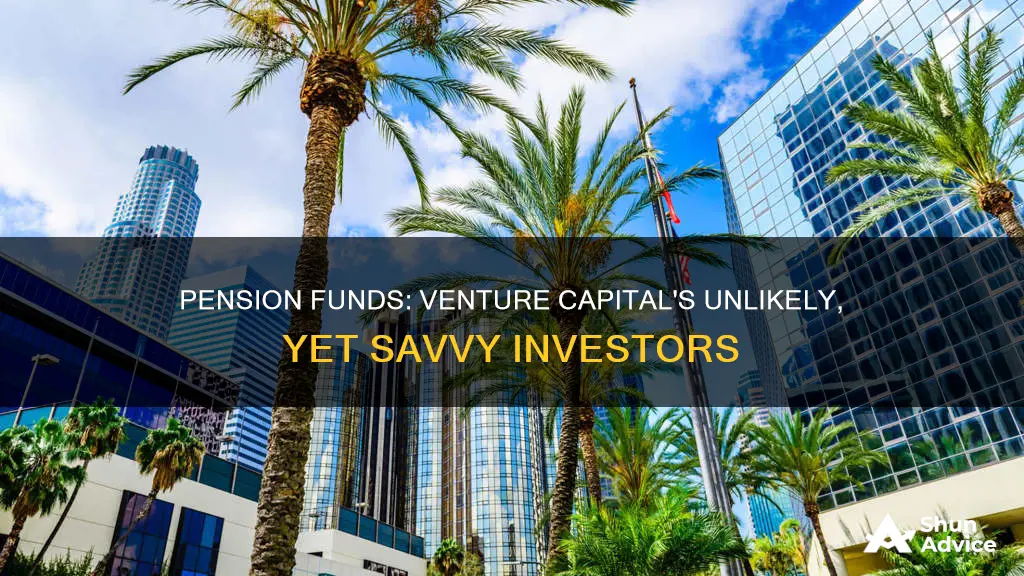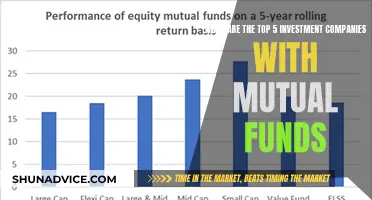
Pension funds have traditionally been limited to investing in low-risk assets such as government securities, investment-grade bonds, and blue-chip stocks. However, changing market conditions and the need to maintain high returns have led to a shift in investment strategies. Pension funds are now exploring venture capital investments to boost retirement pots and support business growth. This diversification can be advantageous, especially during market downturns, as it provides access to a wider range of opportunities and helps mitigate risks. While there are challenges, such as regulatory constraints and higher fees associated with venture capital, the potential for higher returns makes it an attractive option for pension funds to consider.
| Characteristics | Values |
|---|---|
| Returns | Between 1970 and 2016, venture capital and growth equity returned on average 18% per year, compared to 11% for the MSCI World Index |
| Diversification | Venture capital hasn't been closely correlated with equity markets, offering diversification |
| Illiquidity premium | Pension funds can benefit from the illiquidity premium due to their long-term nature |
| Regulatory obstacles | The 0.75% cap on annual charges for defined contribution pension funds is holding back investment in venture capital |
| Regulatory confusion | Regulations requiring regular valuations of pension fund investments are causing confusion regarding how and when to present the value of venture investments |
What You'll Learn

Venture capital's high returns
Pension funds are increasingly investing in venture capital to boost retirement pots and help businesses grow. Venture capital has produced impressive returns, with a report by the British Business Bank and Oliver Wyman finding that between 1970 and 2016, venture capital and growth equity returned on average 18% per year, compared to 11% for the MSCI World Index. This shows that venture capital can provide a vital slice of economic growth for pension funds.
The high returns of venture capital are particularly attractive to pension funds as they seek to maintain a high enough rate of return to ensure that retirees receive the benefits they were promised. Changing market conditions have led to pension plan rules that allow investments in most asset classes, and venture capital is an appealing option due to its potential for high returns.
In its purest form, private equity, a type of investment similar to venture capital, represents managed pools of money invested in the equity of privately held companies with the intention of eventually selling the investments for substantial gains. Private equity fund managers charge high fees based on promises of above-market returns. This structure contributes to the potential for higher returns in venture capital investments.
The long-term nature of venture capital investments also aligns with the investment horizon of pension funds. Pension funds can benefit from the illiquidity premium, which is the premium that comes from being able to tolerate not being able to sell the asset easily. This further enhances the potential for high returns from venture capital investments.
Additionally, venture capital offers diversification benefits due to its low correlation with equity markets. A study found that between 1970 and 2016, there was only a 10% correlation between global venture capital/growth equity average returns and MSCI World Index returns. This diversification can help mitigate against downturns and reduce overall risk for pension funds.
Index Funds: When to Invest for Maximum Returns
You may want to see also

Diversification and mitigating losses
Pension funds have traditionally been invested in stocks and bonds, with a focus on dividends and growth. However, changing market conditions and the need to maintain high returns have led to pension plans allowing investments in a wider range of asset classes. This includes private equity, real estate, infrastructure, and securities like gold.
One of the main reasons for this diversification is to mitigate losses. By investing in a variety of asset classes, pension funds can reduce their exposure to any one particular market or asset. This helps to protect against downturns and market volatility.
For example, during an economic downturn, traditional stocks and bonds may lose value, but investments in real estate or infrastructure may be less affected. By having a mix of investments, pension funds can aim to achieve overall positive returns even when certain markets are struggling.
Additionally, investing in venture capital can provide access to high-growth companies and industries that may offer higher returns than more established companies. While these investments carry more risk, they can also provide diversification benefits due to their low correlation with traditional equity markets.
Venture capital has the potential to offer impressive returns. A report by the British Business Bank and Oliver Wyman found that between 1970 and 2016, venture capital and growth equity returned an average of 18% per year, compared to 11% for the MSCI World Index. This indicates that even a small allocation of a pension fund's portfolio to venture capital could potentially boost overall returns significantly.
In summary, by diversifying into venture capital and other alternative investments, pension funds can mitigate losses, reduce their exposure to market downturns, and take advantage of high-growth opportunities to boost retirement savings for their members.
Roku's Investment Funds: Who's Backing the Streaming Giant?
You may want to see also

Illiquidity premium
Pension funds have traditionally been limited to investing in low-risk assets such as government securities, investment-grade bonds, and blue-chip stocks. However, changing market conditions and the need to maintain competitive returns have led to pension funds branching out into other asset classes, including private equity, real estate, and infrastructure.
One such alternative investment category is venture capital, which has produced impressive historical returns. Venture capital offers pension funds the opportunity to boost retirement pots and help businesses grow. Given the long-term nature of venture capital investments, pension funds can benefit from the illiquidity premium.
The illiquidity premium refers to the additional return earned by investing in assets that cannot be easily sold or traded. Pension funds, with their long-term investment horizons, are well-suited to tolerate the lack of liquidity associated with venture capital investments. By committing capital for an extended period, pension funds can command a premium in the form of higher returns.
However, the current regulatory environment surrounding pension funds and their investment practices poses challenges for investing in venture capital. Regulations require pension fund investments to be valued regularly, which can be difficult for illiquid assets like venture capital. The complexity of valuing these investments accurately and the potential for higher fees associated with active management of venture capital funds are factors that need to be carefully considered and addressed by both the government and regulators.
Despite these challenges, the potential benefits of investing in venture capital are significant. Pension funds that allocate a small portion of their portfolio to venture capital can enhance diversification, mitigate risks associated with downturns, and capture a larger share of economic growth.
Gilt Funds: When to Invest for Maximum Returns
You may want to see also

Pension funds' changing investment patterns
Pension funds are changing their investment patterns. Traditionally, pension funds have been limited to investing in low-risk assets such as government securities, investment-grade bonds, and blue-chip stocks. However, changing market conditions and the need to maintain high returns have led to pension funds diversifying their portfolios and investing in a wider range of asset classes. This includes private equity, real estate, infrastructure, and securities like gold.
One area that pension funds are increasingly exploring is venture capital. Venture capital has the potential to boost pension returns and help businesses grow. While it tends to carry more risk than traditional investments, it can also offer higher returns and provide diversification benefits due to its low correlation with equity markets. For example, a report by the British Business Bank and Oliver Wyman found that between 1970 and 2016, venture capital and growth equity returned an average of 18% per year, compared to 11% for the MSCI World Index.
However, there are some challenges and regulatory hurdles that pension funds face when investing in venture capital. In the UK, for instance, there is a 0.75% cap on annual charges for defined contribution (DC) pension funds, which makes investing in venture capital technically difficult due to the higher fees associated with these types of funds. Additionally, the long-term nature of venture capital investments requires pension funds to tolerate illiquidity, which can be challenging given the current focus on daily valuations.
Despite these challenges, pension funds in some countries, such as Canada, are actively pursuing venture capital opportunities, even during market downturns. This shift in investment patterns reflects the changing nature of the global economy and the search for higher returns in a low-interest-rate environment. Pension funds, with their long-term investment horizons and substantial capital, are well-positioned to benefit from the illiquidity premium offered by venture capital investments.
Artificial Intelligence: Mutual Funds for Future Tech Investors
You may want to see also

Venture capital's funding of startups
Venture capital (VC) is a type of financing available to businesses and entrepreneurs. VC firms manage money from various sources, including pension funds, and invest this capital in exchange for equity or ownership stakes in the startups they select. Their percentage of ownership in the business can range from a small amount to a controlling stake of more than 50%.
VC funding is particularly well-suited to startup companies or small businesses with long-term growth potential. These companies often lack access to capital markets, bank loans, or other debt instruments, and VC funding provides them with the capital they need to bootstrap their operations.
VC firms typically focus on emerging companies, while private equity tends to fund established companies. VC funding can range from a few hundred thousand to a few million dollars, depending on the size of the business and the funding stage.
There are several stages of VC funding:
- Pre-seed funding: This is the earliest stage of business development when founders are trying to turn an idea into a concrete business plan.
- Seed funding: This is when a new business seeks to launch its first product. As there are no revenue streams yet, the company will need VC funding to support all of its operations.
- Early-stage funding: Once a business has developed a product, it will need additional capital to ramp up production and sales before it can become self-funding. This typically involves multiple funding rounds, such as Series A, Series B, etc.
- Late-stage funding: This is aimed at businesses that need funding for further development and growth, such as acquiring another company, entering a new market, or preparing for an initial public offering (IPO).
VC funding offers several benefits to startups, including access to capital and expertise in technology, growth strategies, and management. It also provides networking opportunities and improved valuation. However, there are also some potential drawbacks, such as delays in funding decisions, pressure to grow quickly, and the need to accept VC involvement and influence.
Overall, VC funding plays a crucial role in the lifecycle of a new business, providing the necessary capital and support to help startups get off the ground and founders to fulfill their vision.
Mutual Fund Investment: Timing and Location Strategies
You may want to see also
Frequently asked questions
Pension funds are increasingly investing in venture capital to boost retirement pots and help businesses grow. Venture capital has produced impressive returns, and pension funds are well-placed to benefit from the illiquidity premium.
Investing in venture capital can provide pension funds with a higher rate of return compared to traditional investments. It also offers diversification, which can help mitigate against downturns. Additionally, it provides an opportunity to capture a larger share of the country's economic growth.
One of the main challenges is the fee structure of venture capital funds, which typically includes a management fee and a performance fee. This can make it technically difficult for pension funds to manage their fees within the given cap. Additionally, the long-term nature of venture capital investments requires pension funds to tolerate illiquidity, which can be challenging for funds used to offering daily valuations.







